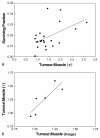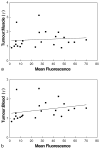The radiation response of cells from 9L gliosarcoma tumours is correlated with [F18]-EF5 uptake
- PMID: 19995239
- PMCID: PMC4110891
- DOI: 10.3109/09553000903242172
The radiation response of cells from 9L gliosarcoma tumours is correlated with [F18]-EF5 uptake
Abstract
Purpose: Tumour hypoxia affects cancer biology and therapy-resistance in both animals and humans. The purpose of this study was to determine whether EF5 ([2-(2-nitro-1-H-imidazol-1-yl)-N-(2,2,3,3,3-pentafluoropropyl)-acetamide]) binding and/or radioactive drug uptake correlated with single-dose radiation response in 9L gliosarcoma tumours.
Materials and methods: Twenty-two 9L tumours were grown in male Fischer rats. Rats were administered low specific activity (18)F-EF5 and their tumours irradiated and assessed for cell survival and hypoxia. Hypoxia assays included EF5 binding measured by antibodies against bound-drug adducts and gamma counts of (18)F-EF5 tumour uptake compared with uptake by normal muscle and blood. These assays were compared with cellular radiation response (in vivo to in vitro assay). In six cases, uptake of tumour versus muscle was also assayed using images from a PET (positron emission tomography) camera (PENN G-PET).
Results: The intertumoural variation in radiation response of 9L tumour-cells was significantly correlated with uptake of (18)F-labelled EF5 (i.e., including both bound and non-bound drug) using either tumour to muscle or tumour to blood gamma count ratios. In the tumours where imaging was performed, there was a significant correlation between the image analysis and gamma count analysis. Intertumoural variation in cellular radiation response of the same 22 tumours was also correlated with mean flow cytometry signal due to EF5 binding.
Conclusion: To our knowledge, this is the first animal model/drug combination demonstrating a correlation of radioresponse for tumour-cells from individual tumours with drug metabolism using either immunohistochemical or non-invasive techniques.
Conflict of interest statement
Figures





Similar articles
-
Noninvasive imaging of tumor hypoxia in rats using the 2-nitroimidazole 18F-EF5.Eur J Nucl Med Mol Imaging. 2003 Feb;30(2):259-66. doi: 10.1007/s00259-002-1037-5. Epub 2002 Nov 23. Eur J Nucl Med Mol Imaging. 2003. PMID: 12552344
-
18F-EF5 PET imaging as an early response biomarker for the hypoxia-activated prodrug SN30000 combined with radiation treatment in a non-small cell lung cancer xenograft model.J Nucl Med. 2013 Aug;54(8):1339-46. doi: 10.2967/jnumed.112.116293. Epub 2013 Jun 5. J Nucl Med. 2013. PMID: 23740105 Free PMC article.
-
Non-invasive evaluation of tumour hypoxia in the Shionogi tumour model for prostate cancer with 18F-EF5 and positron emission tomography.BJU Int. 2007 May;99(5):1154-60. doi: 10.1111/j.1464-410X.2007.06761.x. Epub 2007 Feb 19. BJU Int. 2007. PMID: 17309552
-
2-(2-Nitro-1H-imidazol-1-yl)-N-(2,2,3,3,3-[18F]pentafluoropropyl)-acetamide.2005 Nov 8 [updated 2005 Dec 31]. In: Molecular Imaging and Contrast Agent Database (MICAD) [Internet]. Bethesda (MD): National Center for Biotechnology Information (US); 2004–2013. 2005 Nov 8 [updated 2005 Dec 31]. In: Molecular Imaging and Contrast Agent Database (MICAD) [Internet]. Bethesda (MD): National Center for Biotechnology Information (US); 2004–2013. PMID: 20641211 Free Books & Documents. Review.
-
FDG uptake, a surrogate of tumour hypoxia?Eur J Nucl Med Mol Imaging. 2008 Aug;35(8):1544-9. doi: 10.1007/s00259-008-0758-5. Epub 2008 May 29. Eur J Nucl Med Mol Imaging. 2008. PMID: 18509637 Free PMC article. Review.
Cited by
-
In vivo profiling of hypoxic gene expression in gliomas using the hypoxia marker EF5 and laser-capture microdissection.Cancer Res. 2011 Feb 1;71(3):779-89. doi: 10.1158/0008-5472.CAN-10-3061. Epub 2011 Jan 25. Cancer Res. 2011. PMID: 21266355 Free PMC article.
-
How to Modulate Tumor Hypoxia for Preclinical In Vivo Imaging Research.Contrast Media Mol Imaging. 2018 Oct 18;2018:4608186. doi: 10.1155/2018/4608186. eCollection 2018. Contrast Media Mol Imaging. 2018. PMID: 30420794 Free PMC article. Review.
-
18F-EF5 PET Is Predictive of Response to Fractionated Radiotherapy in Preclinical Tumor Models.PLoS One. 2015 Oct 2;10(10):e0139425. doi: 10.1371/journal.pone.0139425. eCollection 2015. PLoS One. 2015. PMID: 26431331 Free PMC article.
-
A simplified synthesis of the hypoxia imaging agent 2-(2-Nitro-1H-imidazol-1-yl)-N-(2,2,3,3,3-[(18)F]pentafluoropropyl)-acetamide ([18F]EF5).Nucl Med Biol. 2012 Oct;39(7):1012-8. doi: 10.1016/j.nucmedbio.2012.05.006. Epub 2012 Jun 22. Nucl Med Biol. 2012. PMID: 22727821 Free PMC article.
-
Comparison of the Hypoxia PET Tracer (18)F-EF5 to Immunohistochemical Marker EF5 in 3 Different Human Tumor Xenograft Models.J Nucl Med. 2014 Jul;55(7):1192-7. doi: 10.2967/jnumed.114.137448. Epub 2014 May 22. J Nucl Med. 2014. PMID: 24854792 Free PMC article.
References
-
- Arbeit JM, Brown JM, Chao KSC, Chapman JD, Eckelman WC, Fyles AW, Giaccia AJ, Hill RP, Koch CJ, Krishna MC, Krohn KA, Lewis JS, Mason RP, Melillo G, Padhani AR, Powis G, Rajendran JG, Reba R, Robinson SP, Semenza GL, Swartz HM, Vaupel P, Yang D. Hypoxia: Importance in tumor biology, noninvasive measurement by imaging, and value of its measurement in the management of cancer therapy. International Journal of Radiation Biology. 2006;82:699–757. - PubMed
-
- Ballinger JR. Imaging hypoxia in tumors. Seminars in Nuclear Medicine. 2001;31:321–329. - PubMed
-
- Beck R, Roper B, Carlsen JM, Huisman MC, Lebschi JA, Andratschke M, Picchio M, Souvatzoglou M, Machulla H-J, Piert M. Pretreatment 18F-FAZA PET predicts success of hypoxia-directed radiochemotherapy using tirapazamine. Journal of Nuclear Medicine. 2007;48:973–980. - PubMed
-
- Bergman J, Solin O. Fluorine-18-labeled fluorine gas for synthesis of tracer molecules. Nuclear Medicine and Biology. 1997;24:677–683. - PubMed
Publication types
MeSH terms
Substances
Grants and funding
LinkOut - more resources
Full Text Sources
